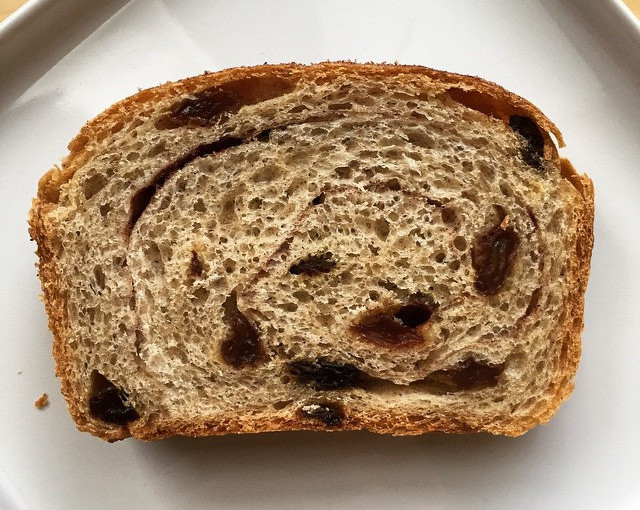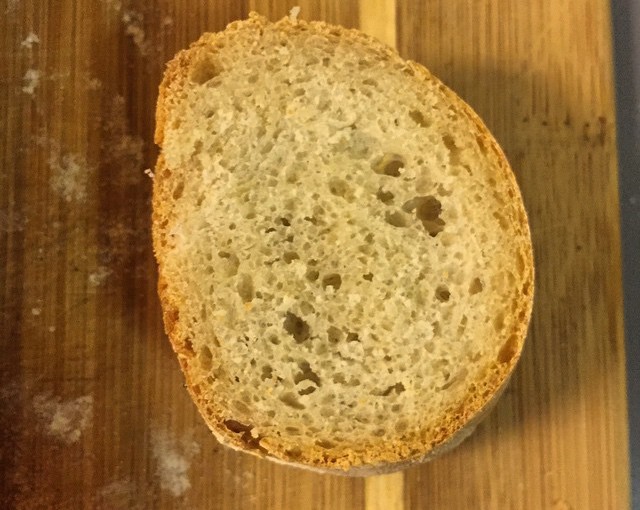
Confession: I don’t like raisins. I’ll eat pretty much any other dried fruit, and enjoy it, but raisins just aren’t my thing. So when I got to this particular recipe for cinnamon raisin bread in The Bread Baker’s Apprentice, my first thought was to just leave the raisins out. Unfortunately, I live in a house of raisin bread lovers, so instead of throwing them out entirely, I decided to split the difference and bake a loaf of with raisins for everyone else, and a loaf with walnuts for me. They were both fantastic.
This recipe produced the softest, most supple dough. It’s got a good amount of fat in it — milk, egg and a touch of vegetable shortening — to keep it from being too dry. It’s also got a healthy dose of cinnamon kneaded right into the dough, which is why this is definitely cinnamon raisin bread and not just, well, raisin bread.
 Adding chunky ingredients like dried fruit and nuts should always be done towards the end of the kneading process, otherwise they end up getting squished. I divided the dough in half before incorporating the walnuts and raisins, then folded the ingredients in until they were (somewhat) evenly distributed.
Adding chunky ingredients like dried fruit and nuts should always be done towards the end of the kneading process, otherwise they end up getting squished. I divided the dough in half before incorporating the walnuts and raisins, then folded the ingredients in until they were (somewhat) evenly distributed.
The bread also has a spiral of cinnamon sugar swirling through it, which is easy enough to add but looks fancy — just sprinkle a healthy layer of cinnamon sugar into the dough before rolling it up into a loaf shape. I added extra raisins during this stage, to the raisin loaf. I also sprinkled some cinnamon sugar on top of the loaves, which looks and tastes great, but makes them slightly sticky on the outside, especially after a day or two of sitting around in the kitchen. I would probably skip the cinnamon sugar crust next time in favor of an egg or butter wash.
Cinnamon Raisin Bread and Cinnamon Walnut Swirl Bread
Adapted from Peter Reinhart’s Bread Baker’s Apprentice
Yields two smallish loaves or one biggish loaf
Ingredients
- 3.5 cups (16oz) unbleached bread flour
- 4 tsp granulated sugar
- 1 1/4 tsp salt
- 2 tsp instant yeast
- 1 1/4 tsp ground cinnamon
- 1 large egg, slightly beaten
- 2 tbsp shortening, melted or at room temp
- 1/2 cup buttermilk or whole milk, room temp
- 3/4 cup water
- 1 1/4 cup raisins, rinsed and drained (optional)
- 1 cup chopped walnuts (optional)
For Filling/Topping:
- 1/2 cup sugar
- 2 tbsp cinnamon
Process
- Stir together dry ingredients (flour, sugar, salt, yeast and cinnamon) in a mixing bowl.
- Add wet ingredients and stir until ingredients come together.
- Turn dough out onto a floured counter and knead for 10 minutes. The dough should be soft and silky– not too stiff or sticky (although at this point it’s better that it’s slightly on the wet side, so add flour or water to adjust as necessary.
- Add most of the raisins or walnuts (or both), and knead for about 2 minutes — you want them to be fairly well distributed, but don’t knead so long that they start to fall apart.
- Shape the dough into a ball and return to an oiled bowl, covering with plastic wrap. Let rest for 2 hours, or until dough doubles in size.
- If you’re baking 2 loaves, divide into 2 equal pieces and form them into loaves. Place the loaves in greased bread pans and mist the top with spray oil, then cover loosely.
- Forming Loaves: Gently press the piece of dough into a 5×8 rectangle. Sprinkle liberally with cinnamon sugar, and the remaining raisins or walnuts, if using. Starting at one of the short ends, roll up into a loaf, pinching the seam closed to seal.
- Proof at room temperature for 60-90 minutes. The tops of the loaves should crest the top of the pans and swell considerably. Preheat the oven to 350F while the loaves are rising.
- Bake the loaves for 20 minutes. Rotate the pans 180 degrees and back for another 20-30 minutes. Note: If you’re baking a large loaf, it may take longer. The loaves will be golden brown and should sound hollow when tapped on the bottom.
- Immediately remove the loaves from their pans and cool on a rack for at least 1 hour before slicing. Enjoy cinnamon raisin bread plain, or toasted with a slather of butter.








